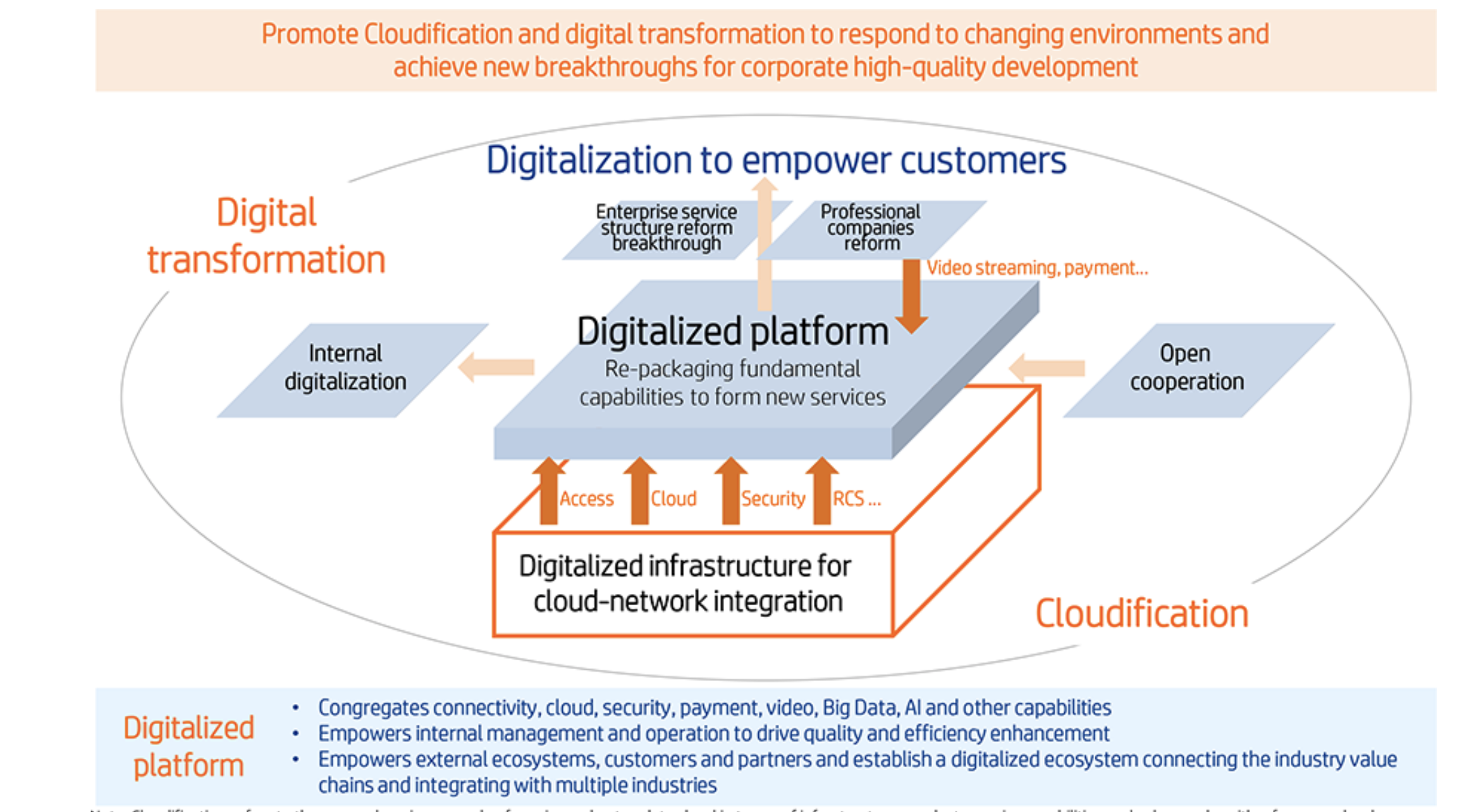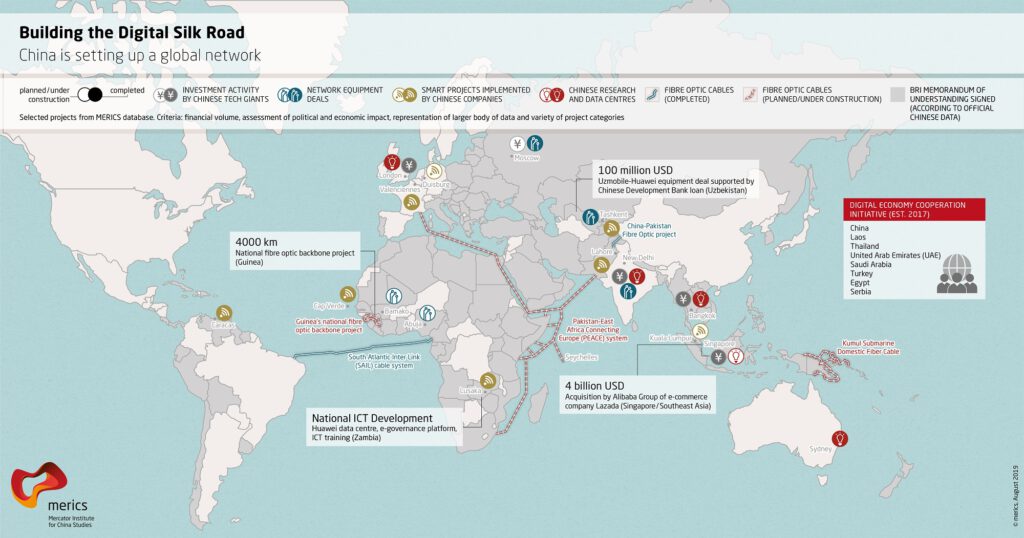
From 27th to 28th December 2020, China Telecom held its 2021 annual work conference in Beijing. As one of the largest and state-owned China telecommunications corporations, its annual work plan reflects the industrial development trend under the direction of the Chinese government. Leaders from China’s Ministry of Industry and Information Technology (MIT), National Audit Office, State-owned Assets Supervision and Administration Commission (SASAC), and Ministry of Finance attended the conference and provided guidelines to the following steps of the corporation.
The conference outlined that though facing a very unusual 2020, the company proactively implemented the strategy of cloudification and digital transformation and acceleratedly promoted cloud-network integration.

Cloudification and digital transformation are the main development trends worldwide not only for technology companies but also for other industries. Cloudification refers to the comprehensive upgrade of service and network to cloud in terms of infrastructure, product service capabilities, and sales mode, with a focus on cloud computing since cloud-based programs may require an online connection at all times or be able to run offline when necessary. Plus, digital transformation is a huge challenge but also a trend of cloudification, or more precise, a high-level development that everything can be digitalized.
Cloudification and digital transformation are the main development trends worldwide not only for technology companies but also for other industries. Cloudification refers to the comprehensive upgrade of service and network to cloud in terms of infrastructure, product service capabilities, and sales mode, with a focus on cloud computing since cloud-based programs may require an online connection at all times or be able to run offline when necessary. Plus, digital transformation is a huge challenge but also a trend of cloudification, or more precise, a high-level development that everything can be digitalized.
The conference pointed out that currently, the industry of information and communications is in an important period of strategic opportunities, China Telecom is in urgent need of laying out ahead and deepening reform. Through the analysis in various aspects such as economic development, technological advancement, customer demand, Industrial trend, and facing risk, China Telecom needs to proactively grasp vertically industrial opportunities for development, over-partition connects to enter the area of comprehensive intelligent information services, empowers thousands of industries and expands new corporate space. In the new developing period, China Telecom needs to strengthen the opportunity awareness and risk awareness, designs well, layouts ahead, deepens reform, and focuses on implementation.
Using telecommunications technologies to empower the development has an official name as “5G deterministic networking empowers thousands of industries” defined by the Chinese government. The idea is to call on industry partners to jointly promote the rapid and healthy development of 5G in the industry based on the 5G deterministic networking industry alliance and innovation base, under the new situation that the industry digitization is inevitable and the 5G network’s high bandwidth and low latency allows it to become an optimal choice to adapt the revolution.
The interesting thing is China may be the only nation to fast develop and widely practice the concept in 2020, due to COVID-19, the country publishes series of applications to digitalize the prevention and control of the pandemic, and therefore becomes the first nation to understand the economic facility and trend of the technology, especially when comparing the failure of similar models to take the situation under the control in European countries. Plus, while the COVID-19 pandemic heavily strikes the global economy, the technology industry is experiencing rapid growth, which for China, indicating that the development of digitalization is gradually becoming a new trend in globalization, and the country attaches great importance to digitalization.
Today’s advancement of China’s digitalization can be partial but crucial credit to the wise guideline from the Chinese government. “We are ready to set up cooperation with all countries. Through the development of cross-border e-commerce and the building of information economy demonstration zones, we will be able to spur the growth of worldwide investment and trade, and promote the global development of digital economy,” said China’s President Xi at the Second World Internet Conference. “We should not reject new technologies, which are products of human advancement. We will not reject any technology that helps to raise the standard of our country’s productive forces and improve the living standards of our people,” said him at a national conference related to cyber-security and digitalization in 2016. “We need to achieve innovation-driven development and deepen cooperation in frontier areas such as smart manufacturing and digital economy,” said him at the Second Belt and Road Forum for International Cooperation in 2017. According to the Chinese embassy, digital transformation is widely applied in China’s government and modernization of governance, epidemic prevention and control, rural internet coverage, e-commerce, online education, etc.

Compared with the slow digitalization in western countries, the progress of China’s exploration in digital technology is certainly exciting and goes very well. The necessity to fully implement digitalization is questioned more frequently than to recognize the benefits from it in the public, which often lies in the ecological concern that if the current technology is sufficient to live a life, why have to maximize its existence at the cost of the original ecosystem? Is it meaningful for people who live in the countryside to accept such changes while they are living here because of the balance between the minimum but enough technology and nature?
In another way, the fewer obstacles to promote it in China’s rural districts need to be examined based on the national situation that the majority of these areas are very undeveloped without basic and sufficient infrastructure to satisfy the people’s needs. But we have to understand that China is making a full-covered technological revolution across the nation, its average technological facility will shortly surpass the average level of social infrastructure in western countries, their long-standing proudness but old and outdated, no matter they are willing to face it or not. Applying digital transformation now is in time, or will be too late.
(Source: Cloudcio / Merics / China Telecom)



